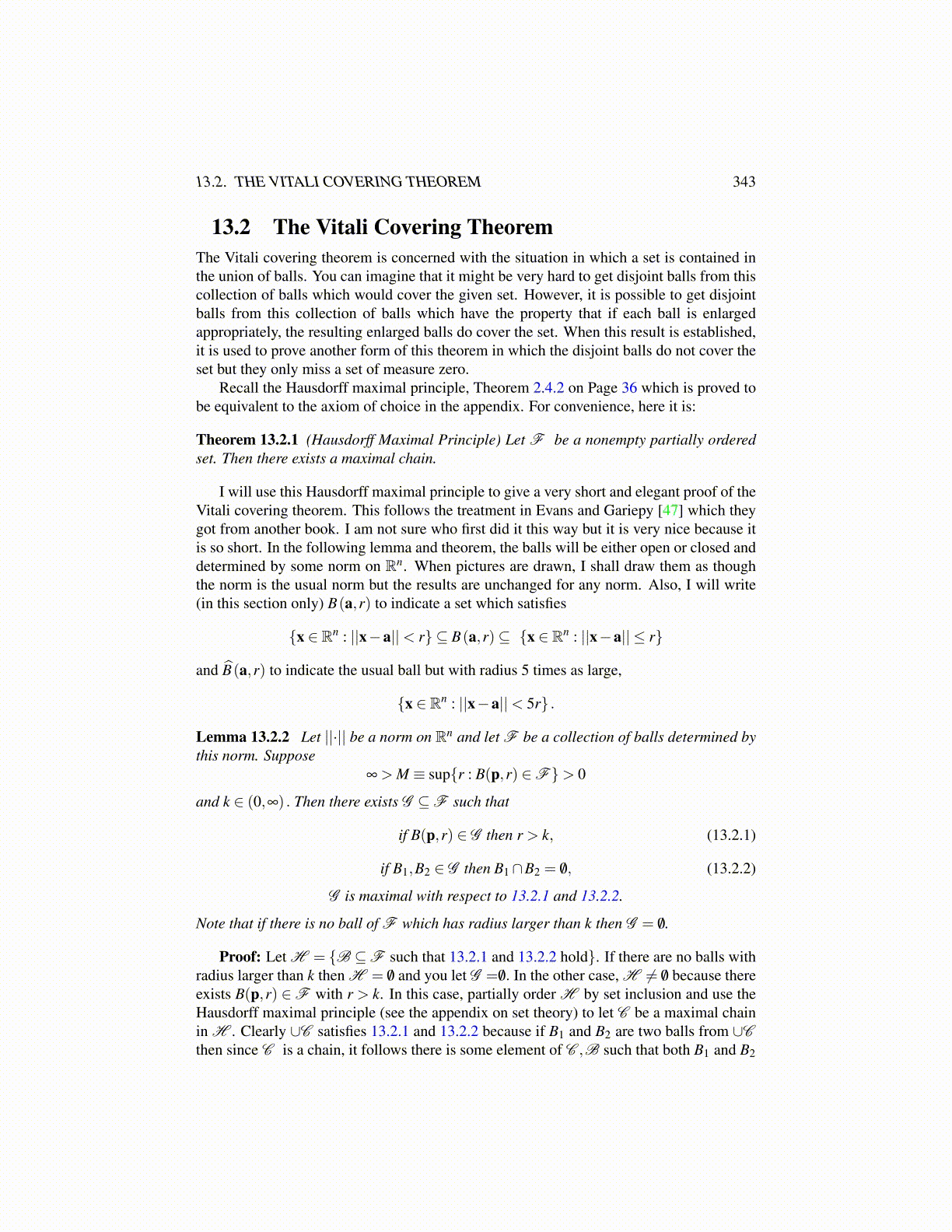
13.2. THE VITALI COVERING THEOREM 343
13.2 The Vitali Covering TheoremThe Vitali covering theorem is concerned with the situation in which a set is contained inthe union of balls. You can imagine that it might be very hard to get disjoint balls from thiscollection of balls which would cover the given set. However, it is possible to get disjointballs from this collection of balls which have the property that if each ball is enlargedappropriately, the resulting enlarged balls do cover the set. When this result is established,it is used to prove another form of this theorem in which the disjoint balls do not cover theset but they only miss a set of measure zero.
Recall the Hausdorff maximal principle, Theorem 2.4.2 on Page 36 which is proved tobe equivalent to the axiom of choice in the appendix. For convenience, here it is:
Theorem 13.2.1 (Hausdorff Maximal Principle) Let F be a nonempty partially orderedset. Then there exists a maximal chain.
I will use this Hausdorff maximal principle to give a very short and elegant proof of theVitali covering theorem. This follows the treatment in Evans and Gariepy [47] which theygot from another book. I am not sure who first did it this way but it is very nice because itis so short. In the following lemma and theorem, the balls will be either open or closed anddetermined by some norm on Rn. When pictures are drawn, I shall draw them as thoughthe norm is the usual norm but the results are unchanged for any norm. Also, I will write(in this section only) B(a,r) to indicate a set which satisfies
{x ∈ Rn : ||x−a||< r} ⊆ B(a,r)⊆ {x ∈ Rn : ||x−a|| ≤ r}
and B̂(a,r) to indicate the usual ball but with radius 5 times as large,
{x ∈ Rn : ||x−a||< 5r} .
Lemma 13.2.2 Let ||·|| be a norm on Rn and let F be a collection of balls determined bythis norm. Suppose
∞ > M ≡ sup{r : B(p,r) ∈F}> 0
and k ∈ (0,∞) . Then there exists G ⊆F such that
if B(p,r) ∈ G then r > k, (13.2.1)
if B1,B2 ∈ G then B1∩B2 = /0, (13.2.2)
G is maximal with respect to 13.2.1 and 13.2.2.
Note that if there is no ball of F which has radius larger than k then G = /0.
Proof: Let H = {B ⊆F such that 13.2.1 and 13.2.2 hold}. If there are no balls withradius larger than k then H = /0 and you let G = /0. In the other case, H ̸= /0 because thereexists B(p,r) ∈F with r > k. In this case, partially order H by set inclusion and use theHausdorff maximal principle (see the appendix on set theory) to let C be a maximal chainin H . Clearly ∪C satisfies 13.2.1 and 13.2.2 because if B1 and B2 are two balls from ∪Cthen since C is a chain, it follows there is some element of C ,B such that both B1 and B2